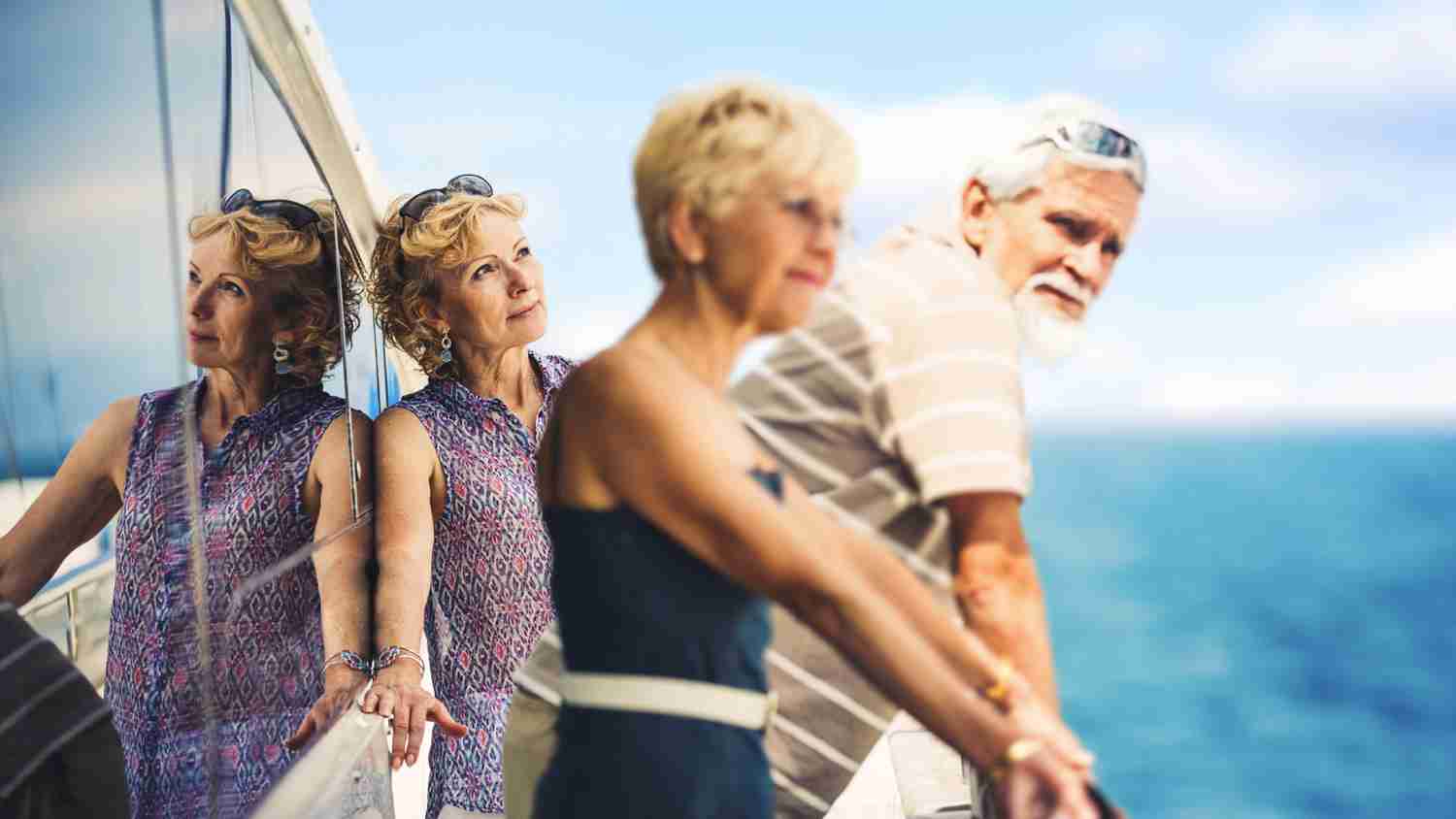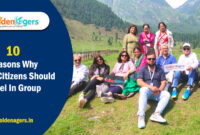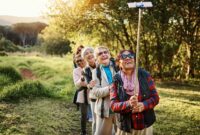Trips for singles over 55 offer a unique opportunity for adventure, relaxation, and cultural immersion. Whether you crave thrilling excursions or prefer tranquil escapes, carefully planned travel caters to diverse interests and activity levels. This guide explores various trip types, destinations, and logistical considerations, ensuring a safe and fulfilling experience for solo travelers in their golden years. We’ll delve into budgeting, health precautions, and strategies for maximizing social interaction, empowering you to embark on the journey of a lifetime.
Types of Trips
Choosing the right trip for singles over 55 involves considering personal preferences, physical capabilities, and budget. This section outlines various trip types, categorized by activity level, along with their advantages and disadvantages. Careful consideration of these factors will ensure a memorable and enjoyable experience.
Trip Types Categorized by Activity Level
This section details different trip options, categorized by activity level: adventure, relaxation, and cultural. Each category includes examples, cost estimates, and social interaction potential.
Adventure Trips
Adventure trips cater to active individuals seeking exciting experiences. Examples include hiking tours in national parks (e.g., exploring the Appalachian Trail sections), kayaking expeditions in coastal areas (e.g., a guided tour of the Florida Keys), or cycling tours through scenic landscapes (e.g., a week-long tour through Tuscany, Italy). These trips offer a high level of physical activity and can be more expensive than other options due to specialized equipment and guide fees. Social interaction is generally high, as participants share experiences and challenges. However, accessibility can be limited for individuals with mobility issues.
Relaxation Trips
Relaxation trips prioritize rest and rejuvenation. Examples include spa retreats (e.g., a week-long stay at a luxury spa in Sedona, Arizona), cruises (e.g., a Caribbean cruise focusing on onboard amenities), or beach vacations (e.g., a relaxing stay at a resort in Hawaii). These trips typically involve less physical activity and are often more expensive than adventure trips, particularly if luxury accommodations are chosen. Social interaction can vary depending on the chosen location and activities, but opportunities for socializing are often built into the experience. Accessibility is generally good, with many resorts and cruise lines offering accessible rooms and facilities.
Cultural Trips
Cultural trips focus on exploring different cultures and historical sites. Examples include guided tours of European capitals (e.g., a ten-day tour of Rome and Florence), visits to historical landmarks (e.g., exploring the ancient ruins of Machu Picchu), or culinary tours (e.g., a week-long food tour of Southeast Asia). These trips offer a moderate level of physical activity, with varying costs depending on the destination and the type of accommodation. Social interaction is often high, as participants share experiences and learn from each other. Accessibility can vary depending on the specific locations visited, but many cultural sites offer accessible facilities.
Trip Type Comparison Table
The following table summarizes the key characteristics of each trip type:
| Trip Type | Activity Level | Average Cost (per person, 7 days) | Social Interaction Level |
|---|---|---|---|
| Adventure Trip (Hiking) | High | $2,000 – $4,000 | High |
| Relaxation Trip (Spa Retreat) | Low | $3,000 – $7,000 | Medium |
| Cultural Trip (European City Tour) | Medium | $2,500 – $5,000 | High |
Destinations
Choosing the right destination is crucial for a fulfilling solo trip, especially for travelers over 55. The ideal location offers a balance of cultural richness, convenient amenities, and a welcoming atmosphere conducive to relaxation and exploration. Factors such as ease of navigation, readily available healthcare, and opportunities for socializing should all be considered.
Many destinations cater specifically to the needs and preferences of mature solo travelers. These locations prioritize accessibility, safety, and opportunities for engaging with local culture and other travelers. A well-chosen destination can significantly enhance the overall travel experience, fostering independence and creating lasting memories.
Popular Destinations for Singles Over 55
Several destinations consistently appeal to single travelers over 55 due to their combination of cultural attractions, ease of navigation, and supportive infrastructure. These locations often offer a mix of historical sites, natural beauty, and opportunities for social interaction, making them ideal for independent exploration and relaxation.
Destinations Tailored for Solo Travelers Over 55
- San Sebastian, Spain: This Basque Country city boasts stunning architecture, delicious pintxos (Basque tapas), and a vibrant cultural scene. The compact city center is easily walkable, and the friendly locals are welcoming to visitors. Numerous walking tours and cooking classes cater specifically to mature travelers. The city also features a relaxed atmosphere ideal for independent exploration and people-watching in charming plazas.
- Florence, Italy: Rich in Renaissance art and history, Florence offers a blend of iconic landmarks like the Uffizi Gallery and the Duomo, alongside charming cafes and artisan workshops. The city is relatively compact and easy to navigate on foot, with readily available public transportation. Many guided tours and cooking classes are designed for smaller groups, allowing for more personal interaction.
- Quebec City, Canada: This historic city offers a unique blend of European charm and North American convenience. The cobblestone streets, charming boutiques, and impressive fortifications create a picturesque setting. English and French are widely spoken, making communication easy. The city is walkable, and public transportation is readily available. Many museums and historical sites are accessible and offer informative tours.
- Cusco, Peru: For those seeking a more adventurous experience, Cusco offers a gateway to Machu Picchu and the breathtaking Andes Mountains. While the altitude may require some acclimatization, the city itself is rich in Inca history and culture. Numerous guided tours cater to different fitness levels, and the vibrant local culture provides ample opportunities for immersion. Many accommodations offer amenities tailored to older travelers.
- Budapest, Hungary: Known for its thermal baths, grand architecture, and rich history, Budapest offers a relaxing and culturally enriching experience. The city is relatively flat and easy to navigate, with an extensive public transportation system. Many thermal baths offer spa treatments and relaxation facilities, perfect for solo travelers seeking rejuvenation. The city’s many cafes and restaurants offer a welcoming atmosphere for socializing.
Travel Planning & Logistics
Planning a trip as a single traveler over 55 requires careful consideration of various logistical aspects to ensure a smooth and enjoyable experience. This section addresses key elements of trip planning, from securing transportation and accommodation to prioritizing safety and well-being. Understanding these factors will empower you to create a memorable and stress-free adventure.
Transportation Options for Solo Travelers
Choosing the right mode of transportation is crucial for solo travelers, particularly those over 55. Factors such as ease of navigation, accessibility, and personal comfort should be considered. Flying offers speed and convenience for long distances, but can be tiring. Train travel often provides a more relaxed and scenic journey, with opportunities to interact with fellow passengers. Bus travel is generally more budget-friendly but may involve longer travel times and less comfort. Renting a car offers flexibility but requires careful consideration of driving conditions and personal driving capabilities. For shorter distances or within cities, utilizing public transportation or ride-sharing services can be convenient and cost-effective.
Securing Accommodation: A Step-by-Step Guide
Booking suitable accommodation is vital for a successful trip. Begin by identifying your preferred type of lodging (hotel, vacation rental, etc.) and desired amenities. Online travel agencies (OTAs) like Expedia, Booking.com, and Kayak offer a wide selection and comparison tools. Consider reading reviews from other travelers, paying close attention to comments regarding accessibility and safety features for older adults. When booking, ensure you understand cancellation policies and confirm the reservation details. For longer stays, consider contacting accommodations directly to negotiate rates or request specific amenities. Pre-booking is strongly advised, particularly during peak seasons, to secure your preferred choice and pricing.
Booking Flights: Tips for Best Deals and Smooth Travel
Finding affordable and convenient flights is key to budget-conscious travel. Utilize flight comparison websites to identify the best options and prices. Consider flying mid-week or during off-peak seasons for potential savings. Be flexible with your travel dates, as prices can vary significantly depending on the day of the week and time of year. Look for package deals that combine flights and accommodation for potential discounts. When booking, ensure your passport is valid and that you have made necessary visa arrangements if required. Check baggage allowances and any restrictions on carrying certain items. Print or save electronic copies of your flight itinerary and other travel documents.
Travel Insurance for Older Adults Traveling Alone
Travel insurance is highly recommended, particularly for solo travelers over 55. A comprehensive policy should cover medical emergencies, trip cancellations, lost luggage, and other unforeseen circumstances. Look for policies that offer extensive medical coverage, including emergency medical evacuation, which is especially important for those with pre-existing health conditions. Consider policies that offer 24/7 assistance services, providing peace of mind in case of unexpected events. Compare policies from different providers to find the best coverage at a competitive price. Examples of beneficial features include coverage for pre-existing conditions (with appropriate disclosure), trip interruption insurance, and emergency medical transport. Always carefully review the policy terms and conditions before purchasing.
Social Aspects & Companionship
For many singles over 55, travel is as much about social connection as it is about sightseeing. The desire for companionship and shared experiences often influences travel choices, leading to a consideration of solo versus group travel and strategies for maximizing social interaction. This section explores the various ways to foster social connections while traveling, addressing the benefits and challenges of different approaches.
Finding travel companions or joining group tours specifically designed for singles over 55 offers numerous advantages. It allows individuals to share experiences, reduce the cost of travel, and build new friendships with like-minded people.
Finding Travel Companions and Group Tours
Several avenues exist for finding travel companions or joining suitable group tours. Dedicated websites and online forums cater specifically to mature singles interested in travel. These platforms often facilitate the formation of travel groups or allow individuals to connect with others planning similar trips. Additionally, numerous tour operators specialize in organizing group tours specifically for the 55+ demographic, often incorporating social activities and events into the itinerary. Many local senior centers or community organizations also offer travel opportunities, often including group discounts and facilitated social interaction. Word-of-mouth referrals from friends and family can also be a valuable resource.
Solo Travel versus Group Travel: Benefits and Drawbacks
Solo travel offers unparalleled freedom and flexibility. Individuals can customize their itineraries, choose activities based on personal preferences, and enjoy the solitude and self-discovery that independent travel provides. However, it can also be isolating at times, especially for those who value social interaction. Conversely, group travel offers built-in companionship and the opportunity to meet new people. The structured itinerary reduces the planning burden, and shared experiences often foster strong bonds. However, group travel may lack spontaneity and require compromises in terms of activity choices and pace. For example, a solo traveler might choose to spend an extra day hiking in a national park, while a group tour might have a fixed schedule that doesn’t allow for this. A solo traveler might enjoy a quiet evening reading a book, while a group tour might involve a lively group dinner that isn’t appealing to everyone.
Strategies for Maximizing Social Interaction During Solo Travel
Even when traveling alone, it is entirely possible to maximize social interaction. Staying in accommodations with communal spaces, such as hostels or guesthouses with shared lounges, provides opportunities to meet fellow travelers. Participating in local activities and tours allows for interaction with other participants. Engaging in conversations with locals in restaurants, cafes, or shops can lead to enriching encounters. Joining walking tours or cooking classes provides structured opportunities for social interaction within a group setting. Utilizing travel apps and forums designed for connecting with other travelers can help establish connections before and during the trip. For instance, a traveler might use an app to find walking tours in a particular city and then strike up conversations with fellow participants. This proactive approach significantly increases the chances of building friendships and creating lasting memories.
Budgeting & Financing
Planning a fulfilling trip requires careful consideration of finances. A well-structured budget ensures you can enjoy your adventure without unexpected financial strain. This section will guide you through creating a realistic budget and identifying potential cost-saving strategies.
Creating a Realistic Budget involves a systematic approach to account for all anticipated expenses. This includes not just the obvious costs like flights and accommodation but also lesser-considered expenses that can quickly add up.
Trip Expense Categorization and Estimation
To create a comprehensive budget, start by categorizing your expected expenses. A typical breakdown might include:
- Flights: Research flight prices well in advance and consider budget airlines or using flight comparison websites to find the best deals. Factor in potential baggage fees.
- Accommodation: Explore various options such as hotels, guesthouses, vacation rentals (Airbnb, VRBO), or even hostels (depending on your preference). Consider the location’s proximity to attractions to minimize transportation costs.
- Activities & Tours: Research the cost of planned activities, tours, and entrance fees to museums or attractions. Look for discounts or combination tickets.
- Food & Drink: Estimate daily food expenses, factoring in meals, snacks, and drinks. Consider the cost of eating out versus self-catering.
- Transportation: Include costs for ground transportation, such as taxis, buses, trains, or rental cars. Factor in parking fees if applicable.
- Miscellaneous Expenses: Account for unforeseen expenses, such as souvenirs, tips, laundry, and any unexpected medical costs. A buffer of 10-15% of your total estimated cost is recommended.
Once you’ve categorized your expenses, research the average cost for each in your chosen destination. Use online resources, travel blogs, and forums to get a realistic estimate. Then, add up all the estimated costs to arrive at a total trip budget.
Cost-Saving Strategies for Travel and Accommodation
Several strategies can help reduce travel expenses without sacrificing the quality of your experience.
- Travel during the off-season or shoulder season: Flights and accommodations are often cheaper during less popular travel times.
- Consider alternative accommodations: Explore options like vacation rentals or guesthouses instead of hotels. These can often offer better value for money, especially for longer trips.
- Take advantage of free activities: Many destinations offer free or low-cost activities, such as walking tours, hiking trails, and free museum days.
- Pack light: Avoid checked baggage fees by packing efficiently. This also saves time and hassle at the airport.
- Utilize public transportation: Public transportation is usually cheaper than taxis or rental cars, especially for shorter distances.
- Cook some of your own meals: Eating out for every meal can be expensive. Prepare some of your own meals or snacks to save money.
Financial Considerations for Older Adults
Older adults may be eligible for various travel discounts and financial assistance programs.
- Senior discounts: Many airlines, hotels, and attractions offer discounts for travelers aged 55 or older. Always inquire about senior discounts when booking.
- AARP membership: Membership in organizations like AARP can provide access to travel discounts and other benefits.
- Travel insurance: It is crucial to consider comprehensive travel insurance, especially for older adults, to cover potential medical emergencies or trip cancellations.
- Exploring potential travel grants: Some organizations offer travel grants specifically for older adults. Research potential grant opportunities related to your interests or specific travel plans.
Remember to factor in any potential medical expenses and ensure adequate travel insurance coverage. A well-planned budget, combined with smart cost-saving strategies, can make your dream trip a reality.
Health & Safety Considerations
Traveling solo after 55 offers incredible opportunities, but prioritizing health and safety is paramount. This section details essential precautions to ensure a worry-free and enjoyable trip. Proactive planning and awareness can significantly mitigate potential risks.
Necessary Vaccinations and Medical Preparations
Before embarking on any trip, consulting your physician is crucial. Discuss your itinerary and receive recommendations for necessary vaccinations based on your destination. This may include routine vaccinations like influenza and tetanus, as well as those specific to your travel location, such as yellow fever or typhoid. Your doctor can also advise on necessary medications, including prescription refills and over-the-counter remedies for common ailments like upset stomachs, headaches, and allergies. Consider carrying a comprehensive first-aid kit tailored to your needs and including any personal medications. It’s also wise to inform your doctor of your travel plans and obtain a copy of your medical records for easy access if needed.
Personal Security and Emergency Preparedness
Solo travel requires heightened awareness of personal security. Before departure, research your destination’s safety guidelines and potential risks. Share your itinerary with a trusted friend or family member, including flight details and accommodation information. Register with your country’s embassy or consulate in your destination country. Be mindful of your surroundings and avoid walking alone in poorly lit or isolated areas, especially at night. Keep valuables secure and avoid displaying expensive jewelry or electronics. Familiarize yourself with local emergency numbers and have a readily accessible list of important contacts. Consider purchasing travel insurance that includes medical evacuation and repatriation coverage. Learning basic self-defense techniques can also enhance your sense of security.
Accessing Healthcare Services While Traveling
Knowing how to access healthcare services while traveling is vital. Travel insurance often provides access to medical assistance networks, offering guidance and facilitating appointments with local doctors or hospitals. If you are traveling internationally, ensure your insurance covers international medical expenses. Many countries have excellent healthcare systems, but understanding the process for accessing care can vary. Consider researching local healthcare providers in advance and noting their contact information. If you require specialized medical attention, it’s wise to seek out hospitals or clinics affiliated with international medical organizations for greater familiarity with Western medical practices. Always carry a copy of your health insurance card and any relevant medical information.
Illustrative Examples
Choosing the right trip for you depends heavily on your personal preferences and desired pace. Below are two sample itineraries, one focusing on relaxation and the other on activity, to illustrate the possibilities available to single travelers over 55.
Relaxing Coastal Getaway in Portugal
This itinerary focuses on a relaxing week exploring the Algarve region of Portugal, known for its beautiful beaches and charming towns.
Accommodation
A comfortable self-catering apartment in Lagos, providing easy access to beaches and local amenities. The apartment would feature a balcony overlooking the ocean, a well-equipped kitchen, and a comfortable living area.
Transportation
Transportation would primarily involve walking and using local buses. Taxis would be used sparingly for longer distances, and car rental isn’t necessary given the excellent public transport and walkability of Lagos.
Daily Schedule
- Day 1: Arrival in Lagos, settle into the apartment, and enjoy a leisurely stroll along the Meia Praia beach, watching the sunset.
- Day 2: Explore the historic center of Lagos, visit the Ponta da Piedade cliffs and grottos (perhaps via a boat tour), and enjoy a delicious seafood dinner at a local restaurant.
- Day 3: Relax on the beach, swim in the ocean, or simply enjoy the sun. Perhaps take a cooking class focusing on Portuguese cuisine in the afternoon.
- Day 4: Day trip to Sagres, a charming town at the southwesternmost point of Europe, known for its dramatic cliffs and historical significance. Enjoy a picnic lunch overlooking the ocean.
- Day 5: Explore the local markets, purchase some souvenirs, and relax by the pool at the apartment complex.
- Day 6: Enjoy a final morning on the beach, followed by a farewell lunch at a restaurant with panoramic ocean views.
- Day 7: Departure from Lagos.
Active Adventure in Costa Rica
This itinerary focuses on an active week exploring the rainforests and beaches of Costa Rica, emphasizing nature and adventure.
Accommodation
A combination of eco-lodges and boutique hotels, carefully selected for their proximity to activities and commitment to sustainability. Each location will offer comfortable accommodations and local character.
Transportation
A combination of pre-arranged shuttles, domestic flights, and local taxis. This itinerary will involve some travel between locations, but the pre-arranged transportation minimizes logistical concerns.
Daily Schedule
- Day 1: Arrive in San José, transfer to a rainforest lodge near La Fortuna. Afternoon hike to a nearby waterfall.
- Day 2: Zip-lining through the rainforest canopy, followed by a relaxing evening soaking in natural hot springs.
- Day 3: Early morning hike to the Arenal Volcano, followed by a guided nature walk focusing on the local flora and fauna.
- Day 4: Transfer to the Manuel Antonio National Park area. Afternoon exploring the park’s beaches and rainforests, spotting monkeys and other wildlife.
- Day 5: Guided kayaking or stand-up paddleboarding tour along the coast, observing marine life.
- Day 6: White-water rafting on a nearby river, followed by a relaxing evening on the beach.
- Day 7: Departure from Manuel Antonio.
Final Conclusion
Planning a trip as a single traveler over 55 can be both exciting and empowering. By carefully considering your preferences, budget, and health needs, you can create a memorable and enriching experience. Whether you choose a relaxing getaway or an adventurous expedition, remember that the journey itself is as rewarding as the destination. Embrace the freedom of solo travel and discover new horizons, creating lasting memories and enriching your life in the process. Safe travels!




